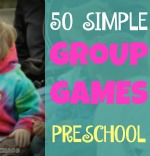Get Camp Activities and Hand Games for Group Circles of all ages Handbook
Remember those hand games and fun group games activities you played in summer camp? Maybe you played games in an after-school program? You remember how much fun they were, maybe you remember the tune or the the general idea, but you just can't remember all the words or just exactly how it goes. Our Circle Time Handbook is made for you. Learn (or relearn) how to play your favorite large group games in a circle.
We've compiled the 39 most popular group games played in a circle with toddlers to teens in a reproducible format. Print them out, place them on your clipboard or share them with your summer camp counselors. These large group circle activity games are perfect for icebreakers and team building. Play them with adults, senior citizens, and youth groups too!
With the complete easy to follow Group Game INSTRUCTIONS, you can play these GROUP TIME Activities right now! All you need is a group of people from toddlers to teens.
Prefer a nice paperback with 8 1/2 x 11 reproducible pages? Order your hard copy on AMAZON, you can also get the Kindle version here. Just click the image to make the purchase on Amazon.
Can't wait? Get the Digital PDF Version of our Circle Time Activities Handbook to start playing right now! Just click the image and visit our TeachersPayTeachers store.
Post contains affiliate links.
We've compiled the 39 most popular group games played in a circle with toddlers to teens in a reproducible format. Print them out, place them on your clipboard or share them with your summer camp counselors. These large group circle activity games are perfect for icebreakers and team building. Play them with adults, senior citizens, and youth groups too!
With the complete easy to follow Group Game INSTRUCTIONS, you can play these GROUP TIME Activities right now! All you need is a group of people from toddlers to teens.
Prefer a nice paperback with 8 1/2 x 11 reproducible pages? Order your hard copy on AMAZON, you can also get the Kindle version here. Just click the image to make the purchase on Amazon.
Can't wait? Get the Digital PDF Version of our Circle Time Activities Handbook to start playing right now! Just click the image and visit our TeachersPayTeachers store.
Lora Langston (that's me) is the creator of Kids Creative Chaos blog. For over fifteen years, I taught enrichment classes in after-school programs, classes at parks for preschoolers, and summer camp.
When it comes to lyrics and how to play games, I have a terrible memory. Every time we played a game, I had to look up the instructions!
Time Management Group Activities: If you are sitting in a circle, waiting for parents to pick up the kids or transitioning to the next activity, sometimes you need an impromptu activity to fill up time. Inevitably, the kids will ask to play a game they've played before, but they don't know how it goes. Been there. Done that.
Now, you have all of those old favorites group activity games at your fingertips! Just print a copy from one of the reproducible pages and attach it to your clipboard. Problem solved. And, it cost less than $10. Enjoy!
 |
| Circle Time activities handbook pdf download. |
Sure, most of these circle time activity games are out there floating around in the public domain. I've been playing many of them since the 1980's! The rest I learned from the kids in my programs from the late 90's to 2012. It sure is convenient to have them all in one place with easy access whenever you need a quick group activity.
If you've played these group games too, and played a different variation, we would love to hear it! Let us know, and we'll add it to our game's post and then send you a thank you Tweet.
Recommended:
FREE Games for Circle Time
FREE Camp Songs for All Ages
Pin it!
 |
| Group Hand Games and Camp Games Book to be played in Circles. |






























